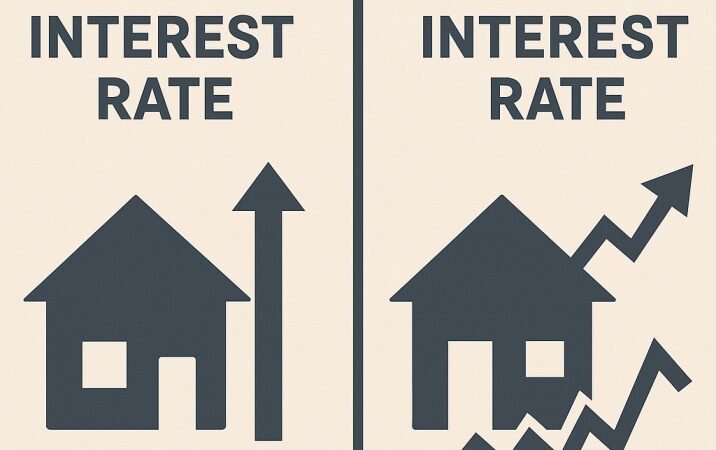When applying for a home loan, one of the biggest decisions you’ll face is:
Should you choose a fixed or a floating interest rate?
This decision can impact not only your monthly EMIs but also your overall cost of borrowing.
Let’s break it down step-by-step — legally, practically, and professionally — so that you can make an informed decision in 2025.
🏦 What Is a Fixed Interest Rate?
A fixed interest rate means your interest remains the same throughout the loan tenure (or for a pre-decided initial period).
You know exactly how much your EMI will be each month.
✅ Pros of Fixed Interest Rate
- Predictable monthly EMI – helpful for budgeting
- Protection from future interest rate hikes
- Ideal in a rising interest rate environment
❌ Cons of Fixed Interest Rate
- Usually 1% to 2% higher than floating rates
- Less flexibility – penalties for prepayment or foreclosure
- No benefit if market interest rates go down
💹 What Is a Floating Interest Rate?
A floating interest rate varies with market conditions and is typically linked to the Repo Linked Lending Rate (RLLR) or MCLR.
As RBI adjusts the repo rate, your EMI may increase or decrease accordingly.
✅ Pros of Floating Interest Rate
- Lower initial rate compared to fixed
- You benefit when RBI cuts interest rates
- Usually no prepayment penalty
- Long-term savings if rates decline
❌ Cons of Floating Interest Rate
- EMIs are not predictable – can increase
- Makes long-term planning slightly uncertain
- Higher financial stress if interest rates rise sharply
📊 Fixed vs Floating Rate – At a Glance
| Factor | Fixed Rate | Floating Rate |
| EMI Predictability | ✅ Stable | ❌ Can Vary |
| Initial Rate | ❌ Higher | ✅ Lower |
| Benefit from Rate Cuts | ❌ No | ✅ Yes |
| Ideal When | Rates Are Rising | Rates Are Falling |
| Prepayment Charges | ✅ Often Applicable | ❌ Usually Nil |
📅 Legal & Financial Implications in 2025
🔸 Loan Agreement Clauses
Always read the loan sanction letter and home loan agreement to understand:
- Lock-in period
- Switching charges (from fixed to floating and vice versa)
- Reset clause and frequency for floating rates
🔸 RBI and RERA Guidelines
Banks and HFCs must transparently disclose the effective interest rate, reset frequency, and foreclosure norms under:
- RBI Master Directions on Housing Finance
- RERA (Real Estate Regulation Act), 2016 in case of project-linked loans
🤔 Which One Should You Choose?
Choose
Fixed Rate
If:
- You want EMI predictability
- You expect interest rates to rise
- You’re on a fixed income like pension or salary
Choose
Floating Rate
If:
- You expect rates to drop or stay stable
- You are financially flexible and can manage EMI variations
- You plan to prepay or foreclose in a few years
🧮 Quick Tip: Use EMI Calculators!
Use trusted bank or RBI-linked EMI calculators to simulate:
- EMI at current floating rate
- EMI under fixed rate
- Total interest payable over time
👨⚖️ Our Legal Perspective
As legal professionals, we often advise clients to:
- Compare total interest outgo over the tenure – not just EMI
- Understand the fine print of rate reset policies
- Avoid “teaser loans” that start low but switch to high fixed rates later
- Review home loan insurance options and prepayment penalties
📌 Conclusion: There’s No One-Size-Fits-All
The choice between fixed and floating depends on your:
- Risk tolerance
- Income stability
- Financial goals
- Market outlook
Both options are legal, viable, and safe — when understood properly.
So take your time, compare rates, read your agreement carefully, and consult a property lawyer or financial advisor before signing the dotted line.
📞 Need Help With Your Home Loan Agreement?
We can assist you with:
- Legal vetting of your home loan agreement
- Comparison of fixed vs floating clauses
- Advice on switching or foreclosure
📧 Email us: ranjinijayaram@rjpropertylaw.com
📱 Call us: +91 80884 17193
🌐 Visit: www.rjpropertylaw.com

